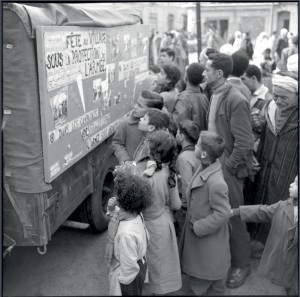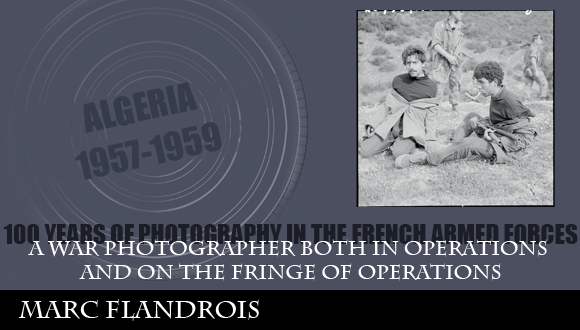Enlisting at the age of nineteen, Marc Flandrois fought in Korea and French Indochina before becoming a photographer in Germany and joining the armed forces film service (SCA) in 1956. An experienced reporter, he was well used to the progress of military operations.
Although the events described in the report’s captions leave little room for doubt, they cannot have been captured spontaneously. The photograph of two prisoners, for example, is clearly staged. The shears found nearby, which constitute incriminating evidence, have been placed in the arms of one of the men. The image composed in this way is even more explicit and could be used as evidence in a criminal trial. And yet it is the impression of a staged image that dominates, an impression amplified by the fear on the faces.
 This was not Flandrois’ only contact with shears: in Oran in 1957 he photographed Opération Cisailles, subject of much media coverage, which pierced the physical boundary separating the Arab and European districts of the city. He took
This was not Flandrois’ only contact with shears: in Oran in 1957 he photographed Opération Cisailles, subject of much media coverage, which pierced the physical boundary separating the Arab and European districts of the city. He took time to capture the event in full: the cutting of the barbed-wire fence by the authorities and then the people passing from one district to the other. Not far from the opening, a psychological operations truck informed people about the army’s role in the villages and drew the attention of people living nearby.
time to capture the event in full: the cutting of the barbed-wire fence by the authorities and then the people passing from one district to the other. Not far from the opening, a psychological operations truck informed people about the army’s role in the villages and drew the attention of people living nearby.
Marc Flandrois photographed military operations many times, but also towns, their inhabitants and the evolving urban fabric, as seen in the photo taken in Algiers during the works of the Constantine Plan.
Photos credits : © ECPAD / Marc Flandrois




Ajouter un commentaire